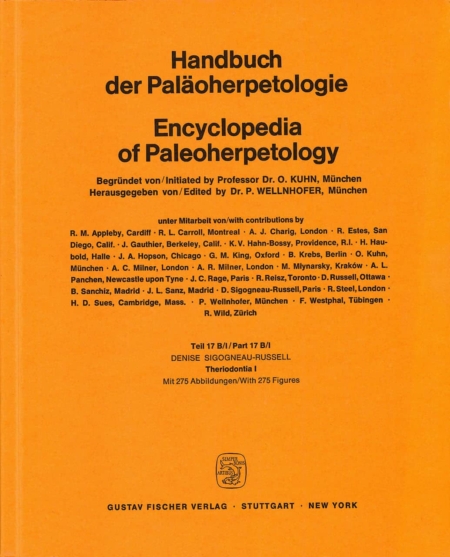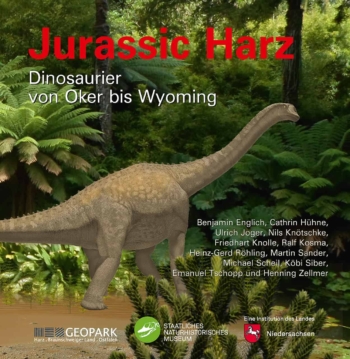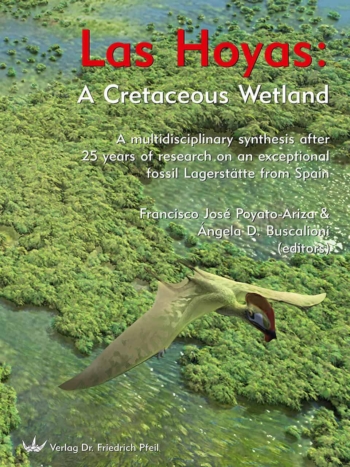Editorial Note V
Acknowledgements VI
Institutional Abbreviations VII
Figure Abbreviations VIII
Introduction 1
Infraorder Phthinosuchia ROMER 1961 3
Osteology 3
Family Phthinosuchidae EFREMOV 1954 3
Family Phthinosauridae TATARINOV 1974 4
Systematic Review 4
Family Phthinosuchidae EFREMOV 1954 4
Family Phthinosauridae TATARINOV 1974 5
Family indet 6
Infraorder Biarmosuchia nov. 8
Osteology 8
Skull 8
Postcranial Skeleton 11
Systematic Review 17
Family Biarmosuchidae OLSON 1962 19
Family Hipposauridae WATSON and ROMER 1956 19
Family Ictidorhinidae BROOM 1932 22
Family Burnetiidae BROOM 1923 25
Infraorder Eotitanosuchia BOONSTRA 1963 27
Osteology 27
Systematic Review 29
Family Eotitanosuchidae CHUDINOV 1960 29
Infraorder Gorgonopsia SEELEY 1895 31
Osteology 31
Skull 31
Postcranial Skeleton 41
Systematic Review 64
Family Watongiidae fam.nov. 64
Family Gorgonopsidae LYDEKKER 1890 65
Subfamily Gorgonopsinae SIGOGNEAU 1970 65
Subfamily Rubidgeinae SIGOGNEAU 1970 101
Subfamily Inostranceviinae subfam.nov. 111
Gorgonopsidae indet. 113
Gorgonopsia ? 114
Phylogenetic Relationships 116
Geographical and Stratigraphical Distribution 120
Literature cited 122
Index of Genera and Species 125
HPH 17B/1 • Theriodontia I
1989. [English] – X, 127 pp., 275 figures.
25,5 x 20,5 cm, Paperback.
Series: Handbook of Paleoherpetology
85,90 € Original price was: 85,90 €.70,00 €Current price is: 70,00 €.
plus shipping costs
The first Theriodonts to be described were Galesaurus and Cynochampsa by OWEN 1860; this author created for them the family Cynodontia (sic), which he included in his new order Anomodontia. But in 1876, when more genera were known, he proposed the new order Theriodontia with the following definition: «dentition of the carnivorous type; incisors defined by position and divided from the molars by a large laniariform canine on each side of both upper and lower jaws, the lower canine crossing in front of the uppers; no ectopterygoids; humerus with an entepicondylar foramen; digital formula of fore foot 2 3 3 3 3 phalanges». From the beginning, then, the emphasis was put on the dentition and the carnivorous status of these animals. Even though the diagnosis of the Theriodontia became considerably more elaborate as our knowledge increased, it remained centered on this carnivorous nature. Thus for HoPSON (1969), the free streptostylic quadrate, which could play a role in allowing lower teeth «to come into contact and shear against the posterior surfaces of upper teeth», is one of the key characters of the Theriodontia. HoPSON and BARGHUSEN (1986) also consider as a main feature the development of the coronoid process, whose role in mastication is evident.
The term Theriodontia as opposed to Anomodontia has become of general use as a suborder; some authors however refrain from mentioning it: BROOM in 1932 did not use it in his famous synthesis of the mammal-like reptiles, though he had often referred to it in separate publications, nor did KEMP in his reevaluation of the mammallike reptiles (1982) who tends to split the group into two lines of development. BOONSTRA (1972) even formally proposed to discard it and replace it by another concept. In the Theriodontia sensu Owen were included genera (with the exception of Procolophon) that later were referred to the infraorders Cynodontia OWEN 1860, Gorgonopsia SEELEY 1895 and Therocephalia BROOM 1903; and it is with this acceptation that the suborder Theriodontia is currently understood (Therocephalia and Cynodontia are sometimes opposed to Gorgonopsia under the denomination Eutheriodontia, for example in HOPSON and BARGHUSEN, 1986). However, ROMER (1956) added not only the Ictidosauria, which are now considered as Cynodontia, but also the Titanosuchia; the attribution of this infraorder has since fluctuated between the Cynodontia and the Deinocephalia. Finally, in the Gorgonopsia was included from its creation the family Hipposauridae WATSON and ROMER 1956 (or Ictidorhinidae BROOM 1932), which thus was considered as part of the Theriodontia. In 1970, a reexamination of the specimens led me to doubt this attribution; in the present work I go even further by incorporating them in the new infraorder Biarmosuchia.
The most ancient Theriodont (sensu OWEN) would be a North American specimen from the Guadeloupian Chickasha Formation, equivalent in age either to the lower Kazanian or lower Tatarian according to the authors, that is, to the base of the upper Permian; but the bulk of the group lived during the last of the upper Permian and the Triassic; only the Tritylodonts ventured into the Jurassic.
Whereas the upper part of the late Permian has furnished a rich therapsid fauna in the two hemispheres, and the early and middle Permian in North America has yielded pelycosaurs, the lower part of the late Permian has remained for a long time unproductive. Consequently, nothing linked these two assemblages that were felt to be related. But, between the 1940's and 1960's was found and described a small number of fossils that proved to be of extreme importance as much from the chronologic point of view as from the morphologic and phylogenetic. They come for the most part from the late Kazanian and the lower Tatarian of the U.S.S.R. and constitute morphologic intermediate forms between pelycosaurs and therapsids. Since that time, unfortunately, no fossils have been found to enrich our still unsatisfactory collection and few studies have contributed to our incomplete knowledge of this material.
In 1962 OLSON created for these forms the infraorder Eotheriodonta, which comprised the Phthinosuchidae EFREMOV 1954 (including Eotitanosuchus and some North American genera), the Biarmosuchidae OLSON 1962 and the Brithopodidae EFREMOV 1954. Later this denomination has frequently been used to conveniently designate these primitive therapsids, most recently by CHUDINOV 1983 and OLSON 1986. It is no longer possible, however, to consider it as a taxonomic unit, as no common and unique specialization supports its monophyletism. The term only defines an evolutionary grade. It will be attempted in this conclusion to express the phylogenetic relations of the different families involved (Brithopodidae excepted), such as they can be perceived in the light of our very incomplete knowledge. At this point, the fact is emphasized that the author disagrees, even more than TATARINOV 1974, with a close association of Eotitanosuchus and Phthinosuchus, or with the position of the latter close to gorgonopsians.
To come back to the concept Theriodontia, whether it should be maintained in the sense of Owen, or whether it should be limited to the Therocephalia and Cynodontia, or on the contrary extended to include at least the Eotitanosuchia, remains, in the incomplete state of our knowledge, essentially a matter of personal appreciation. Consequently the term is omitted here.
As for the infraorder Gorgonopsia, it was defined by SEELEY in 1895 on an erroneous concept of the temporal region of Gorgonops OWEN 1876, the only genus known; this explains why BROOM in 1910, being better informed, integrated Gorgonops in the Therocephalia, but he revalidated the infraorder three years later when he was able, from other specimens, to detect differences between it and the Therocephalia. But only in 1914 did he give the first diagnosis of this infraorder, diagnosis which was later to undergo several alterations and additions; the most complete is that of ROMER 1956, which was slightly modified by SIGOGNEAU 1970a.
The contents of the Gorgonopsia has been considerably enriched since its creation: constituted originally of only Gorgonops, in 1970 this infraorder had increased to 108 species, mostly through the works of BROOM, HAUGHTON, VON HUENE (who described the Tanzanian forms in 1950), and BRINK and KITCHING (1953). That year (1970) SIGOGNEAU proposed a generic grouping of the species (dispersed in 68 genera), but it must be emphasized that our anatomical knowledge of the described specimens remains insufficient to solidly base the taxonomic distinctions within the infraorder; moreover, there exists in the South African collections many unpublished specimens which would contribute notably to our understanding.
These genera and species have either been lumped in two or three families (VON HUENE 1948; HAUGHTON and BRINK 1954; OLSON 1962; SIGOGNEAU 1970a), or subdivided into about 20 (WATSON and ROMER 1956; KUHN 1961; ROMER 1966); but even in the latter case there remained a large number of species which could not be classified. We have, in this work, recognized only two families, the Gorgonopsidae LYDEKKER, 1890 (in fact Gorgonopidae), itself divided into three subfamilies - Gorgonopsinae, Rubidgeinae and Inostranceviinae – and that, new but admittedly questionable, of the Watongiidae.
You must be logged in to post a review.
"*" indicates required fields
We’re here for you
Verlag Dr. Friedrich Pfeil
Hauptstraße 12B
5232 Bergkirchen OT Günding – Germany
Tel.: +49 8131 61 46 590
Fax: +49 8131 61 46 591
E-Mail: info@pfeil-verlag.de
Contact
Tel.: +49 89 742827-0
Fax: +49 89 7242772
E-Mail: info@pfeil-verlag.de






Reviews
There are no reviews yet.